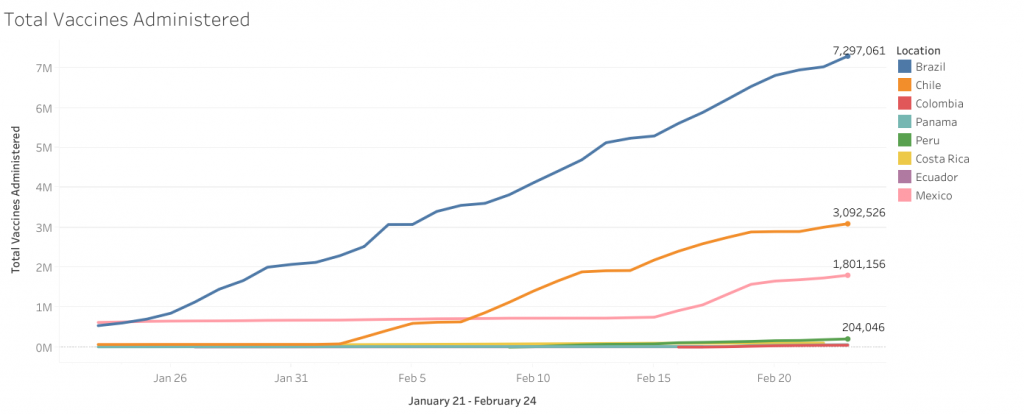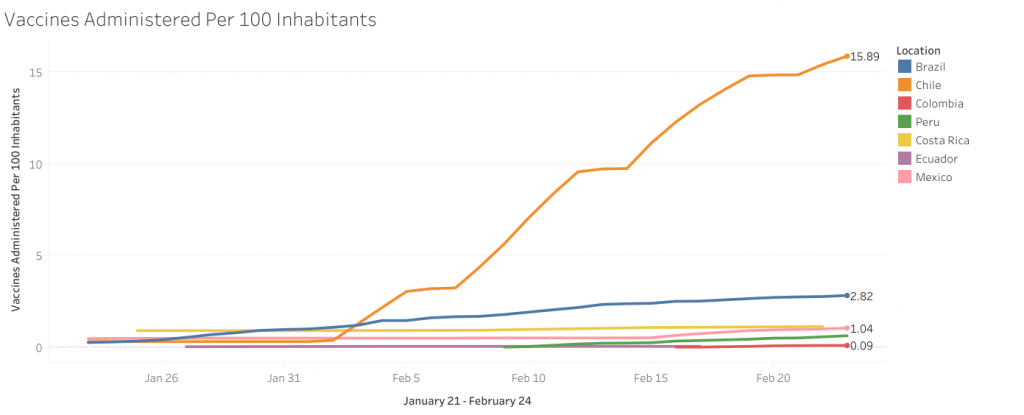One Year Marker of COVID-19 in Latin America and the Caribbean
On February 25, 2020, the first COVID-19 case was detected in Latin America and the Caribbean (São Paulo, Brazil). Since then, the region has had some of the highest infection and death rates in the world. With regional GDP contraction higher than the world average, and with the pandemic facilitating greater inequality and corruption, today we remember those who have fallen victim to the pandemic in Latin American and the Caribbean.
Today’s special edition of Aviso rounds up some of the most startling figures of 2020 and features the most relevant coverage of today, from vaccine rollouts and medical news to economic impacts and projections. At the Adrienne Arsht Latin America Center, we will continue our work to advance solutions on how to most effectively rebuild from COVID-19 in our region. To continue receiving our weekly Aviso newsletter and stay informed of the pandemic’s implications for Latin America, sign up today.
In Case You Missed It…
Infections and Deaths: To date, Latin America and the Caribbean counts 20,862,000 cases (44 percent of global cases) and 663,000 deaths caused by COVID-19.
Poverty: 16 million people have fallen into poverty in Latin America and the Caribbean due to the pandemic.
Gender Inequality: A special report from ECLAC shows that the COVID-19 pandemic will set back women in Latin America more than a decade in terms of labor participation.
Economic Inequality: Oxfam International predicts that the mega rich will recover from economic losses in as little as nine months; those living in poverty will need a decade to recover from the impact of the COVID-19 pandemic.
Corruption: According to Transparency International’s 2020 Corruption Perception index, corruption is prevalent across government’s COVID-19 responses. In the Americas, Canada, Uruguay, United States, and Chile are the best performers; Nicaragua, Haiti, and Venezuela are the worst.
Education: By the end of 2020, 87 percent of Latin America and the Caribbean’s 160 million students had been out of in-person school for eight months. These losses in learning could cost the region up to $1.2 trillion in lifetime earnings, according to the World Bank.
COVID-19 and Commercial Diplomacy: China has donated more than $215 million in supplies to Latin America and the Caribbean and promised $1 billion to facilitate regional vaccine access. While China’s official lending to the region dried up during the pandemic, its mergers and acquisitions activities in Latin America totaled $7 billion in 2020, nearly doubling 2019 figures.
US Support for Multilateralism: As one of his first executive orders, President Joe Biden retracted the United States’ intent to withdraw from the World Health Organization and affirmed the organization’s fundamental role in fighting the COVID-19 pandemic. The Biden administration has also pledged to donate $4 billion. to COVAX, a global initiative aimed at equitable access to COVID-19 vaccines.
Vaccine Status: According to Fitch Ratings, Mexico, Peru, and Chile are best placed in terms of vaccine agreement coverage as a share of their population. Chile, Brazil, and Costa Rica have administered the most doses per capita to date.
Health + Innovation
- Brazil: The Butantan Institute is vaccinating the entire adult population of the city of Serrana in Sao Paulo state to test the effect on COVID-19 infection rates.
- Chile: On February 23, Chile became the first country in Latin America and the Caribbean to administer 3 million vaccines, approximately 16 percent of its total population.
- Mexico: On February 22, Mexico received its first batch of Russia’s Sputnik V vaccine, with 200,000 doses. In total, Mexico expects 24 million doses. That same day, Mexico began inoculations with the Sinovac vaccine after receiving a first shipment from China. The Mexico deal is for 10 million Sinovac vaccine doses.
- Equitable Access: Mexico and Argentina requested the United Nations and the world’s richest countries step up efforts to ensure poor countries can access COVID-19 vaccines, with Mexican President Andrés Manuel López Obrador saying wealthier countries are “hoarding” vaccine supplies.
- Vaccine Passport: Scientists in the UK argue vaccine passports must meet 12 criteria, including being international standardized, having verifiable credentials, being affordable, and meeting ethical standards.
Economies in Focus
Multilateral Analysis
- The Inter-American Development Bank (IDB) signed a Partnership Declaration with a coalition of 40 innovative global and regional companies to aid the region’s COVID-19 recovery. The coalition has pledged to work together in three critical areas to post-pandemic economic recovery: women empowerment, the acceleration of digitalization, and regional value chains.
Economic Relief
- Guatemalan authorities announced a roadmap to attract $300 million in FDI to strengthen the agricultural, textile, fashion, food products, and chemical sectors. The roadmap aims to better position Guatemala for nearshoring opportunities.
- Bolivia returned an IMF loan of $327.7 million, originally granted to help the interim administration combat the effects of the pandemic, citing the onerous burden of the loan.
- The Central American Bank for Economic Development (BCIE) announced that it would provide up to $800 million in loans to the Dominican Republic and Central America to purchase COVID-19 vaccines.
- Through the IDB Lab, Google is providing $8 million for the first permanent regional funding mechanism for microfinance institutions. The IDB Lab also provided $4.5 million to the fund.
Economic Impact
- Mexican Secretary of Economy Tatiana Clouthier announced FDI had fallen by 11.7 percent in 2020 compared to the previous year.
- A study undertaken by the Colombian Confederation of Chambers of Commerce found that 63 percent of firms used digital channels to sell their goods during the pandemic.
- For the first time in 15 years, China’s two largest development banks made no new loans to Latin America in 2020.
Border Restrictions + Quarantines
Quarantines + reopenings
- The Mexican National Association of Private Schools announced that in-person classes would resume on March 1, prompting Mexico City Mayor Claudia Sheinbaum to call for patience and dialogue before moving ahead with the reopening plans.
- Panama reopened gyms, spas, beauty parlors, and other activities in the provinces of Panama Oeste and Panama, where the capital is located.
- The Dominican Republic extended its curfew until March 8; the curfew has been in effect since January 22.
- In an attempt to limit the spread of COVID-19, Havana, Cuba, is using barricades to close streets and control the flow of people in densely populated areas of the city.
- Beginning February 25, Chile will relax its curfew and only require citizens to stay home from 11:00 p.m. to 5:00 a.m.
- Buenos Aires, Argentina will lift its nightly curfew on February 27, allowing bars, restaurants, theaters, and other stores to resume their normal hours.
Border closures
- The Mexican, American, and Canadian governments agreed to keep land borders closed to non-essential travel until March 21, marking a full year since the land borders were first closed.
By the numbers
- Cases by country: Brazil (10,260,621) #3 worldwide, Colombia (2,233,589) #11 worldwide, Argentina (2,077,228) #12 worldwide, Mexico (2,052,266) #13 worldwide, Peru (1,293,497) #19 worldwide, Chile (805,317) #23 worldwide, Panama (337,805) #43 worldwide, Ecuador (275,780) #47 worldwide, Bolivia (244,380) #50 worldwide, Dominican Republic (236,210) #53 worldwide, Source: worldometers.info
- Prevalence rate (total cases per million people: Panama (77,503) #11 worldwide, Aruba (72,249) #12 worldwide, Brazil (48,050) #38 worldwide, Argentina (45,689) #42 worldwide, Colombia (43,596) #47 worldwide, Chile (41,894) #51 worldwide, Costa Rica (39,634) #53 worldwide, Peru (38,880) #56 worldwide, Belize (30,486) #66 worldwide, Curaçao (28,542) #71 worldwide, Source: worldometers.info
- Deaths per capita (deaths per million people): Mexico (1,401) #18 worldwide, Peru (1,367) #19 worldwide, Panama (1,324) #21 worldwide, Brazil (1,164) #26 worldwide, Colombia (1,154) #27 worldwide, Argentina (1,133) #29 worldwide, Chile (1,048) #32 worldwide, Bolivia (977) #35 worldwide, Ecuador (874) #39 worldwide, Belize (781) #45 worldwide, Source: worldometers.info
Quick take


